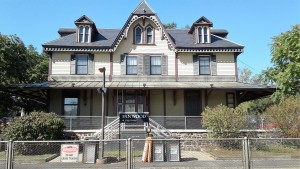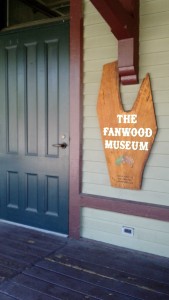Do others feel split between nostalgia and sarcasm, when visiting their old childhood stomping grounds? It was thus I was sorry to miss Fanny Wood Day. It was a few Sundays ago, and Fanwood’s twenty-first. No, I do not have small children who need their faces painted. I will admit up front my interest was typically split between nostalgia and sarcasm, once again.
If I’d gone, I may have been the only cynic there. This event can pull in 10,000 people from surrounding towns, an amazing feat for a town with about 7,000 residents.
There have been featured actresses dressed as the legendary Fanny Wood. There are annual “Dress Up As Fanny Wood” competitions. At first, I thought activities predominantly featured overeating, as in the Ice Cream Eating Competition, and the Pizza Eating Competition. But when I saw the photos, I was amazed at the huge happy crowds and the dozens of activities.
The thing is, it’s not clear there ever was a Fanny Wood. However, Fanwood is named after her. This was my main activity, to investigate her a little.
Before we get to the official version, let’s start with the unsubstantiated, widely accepted rumors.
Fanny Wood Day
A few weeks ago, when I drove past the huge sign “21st Fanny Wood Day” in front of the Fanwood Police Station, my heart leapt for joy. Did I read that right? Oh I did hope so – yes! Fanny Wood, local legend, was being celebrated – a legend totally without evidence, the best kind. I’d moved away decades ago, and had no idea this was going on.
I remember the stories well. We all do. We heard she was the floozy of a railroad baron. Did we get the floozy part wrong? I hope not.
It’s all the better when you remember that in American slang, the word fanny means a rear end, a butt, a gluteus maximus. Whereas in British slang, the word fanny means a woman’s fan-shaped pubic area, or female genitalia generally speaking. So as wrong as it may be, how can one not think of the floozies of the 1900s?
Fanwood vs Scotch Plains
The rest of the legend has some truth, and here is some of it:
“Fanwood”, for the uninitiated, is a small town in central New Jersey, weirdly surrounded on opposite ends by my home town Scotch Plains, which Fanwood cuts in two. The two towns often function as one: most of us went to Scotch Plains Fanwood High School, for example. The entire municipality could easily have functioned as one, as it used to historically. Then came The Split.
Scotch Plains is a long skinny town, about the shape of a fat shoelace. Through the middle ran the Philadelphia-New York train line. Rather, it would have, but there were objections to Scotch Plains becoming known as “a railroad town”, whatever slummy, disreputable thing that meant.
While the current, and beautifully preserved train station houses a museum and community centre, perhaps we can assume that 19th century railroad stations were feared to attract – what? Tramps and thieves? Drunks and prostitutes? Riff-raff and others determined to pull down the fine clean reputation of Scotch Plains, in no way at heart a “railroad town”?
Whatever this fictional fear, the alleged solution was to cordon off a precise square mile – the part the train went through – and call it something different. The township of Fanwood was thus created in 1895, splitting SP in two, and functioning as a reputation-decoy, to deflect mud-slinging at Scotch Plains, both north and south sides. (Another whole division arose from that too.)
If any name was going to sink to the scandalous level of a “railroad town”, it would not be the unsullied name of Scotch Plains, but floozy-led Fanwood, in the eyes of the world.
Not everyone agrees about the above. Fanwood resident and historian to the borough’s Historic Preservation Commission, Joe Nagy, said Fanwood came first, a version I never heard in 50 years, but will pursue in any follow-up posts this inspires.
“Originally part of Fanwood Township founded in the 1870s, the borough broke off in 1895, creating a new community that encircled the train station. The township became Scotch Plains.”
I told you the two towns had issues.
So who the Sam Hill was Fanny Wood?
The favourite theory was that the railroad baron named it after his mistress, or perhaps his euphemistic nickname for her. This was not mentioned on Fanwood’s municipal website. That’s fair enough, in an official version. That website does give us some cleaner basics:
“Fanwood was founded in 1895 around the Central Railroad of New Jersey, which passed through during the 1800s. The old Fanwood train station, built in 1874, stands as the oldest original train station in Union County and remains the center of many community activities. It houses the Fanwood Museum and is a meeting place for various groups.”
“It’s believed Fanwood was named after Fanny Wood, a journalist who wrote about the area. Quoting from a 1973 letter in the Fanwood Museum from Justus Agnoli, Fanwood’s representative to the Union County Cultural and Heritage Commission:
“In 1874 the Central Railroad of New Jersey built a new station to serve this area. Mr. John Taylor Johnson, then president of the new railroad, selected the name FANWOOD for the new station, in honor of Miss Fanny Wood, a frequent visitor to this area, who wrote numerous glowing (accounts)of its scenic beauty for leading New York periodicals, thereby attracting new residents and investors to this section.”
I’m sorry, but I believe I speak for many when I say this is too clean, unconvincing, and lacking in gossipy fun. The floozy version is less boring, which is all we wanted, as teenaged, irresponsible citizens.
More rumors
Here are a few nuggets from an article, more fun and full of rumours, by Ryan Hutchins of The Star-Ledger, The Star-Ledgeron September 29, 2012.
“Who was Fanny Wood? No one, with any certainty, can really say.
“Was she Miss Fanny Wood, who’d ride the train out from New York, sit under a great Oak tree and write glowing poems about the area’s beauty? That’s what the borough’s website tells.
“Was she the privileged daughter of a railroad president who liked to name stations after his family members? That was the version chronicled by the Federal Writers’ Project of the 1930s.
“Or maybe she never existed.
“That’s what seems most likely, locals say. There’s no clear, documented evidence there was a Fanny Wood.
“The rest of us have been searching for many years for anything she ever wrote, for any of her DNA or anything else,” said George Weiss, a local historian, who ran the borough’s TV station until his retirement. This flies in the face of the previous assertion that she existed at all, and wrote for “leading New York periodicals”, which were unnamed and, it seems, never found.
Joe Nagy agrees there is no real trace of Fanny Wood. He goes on, “It was the Fanwood Train Station and the Central Railroad of New Jersey that helped build up the area.
“As part of the Public Works Administration’s Federal Writers’ Project — an effort to employ white-color workers during the Great Depression — Emily de Forest, said to be the daughter of railroad president John Taylor Johnston, wrote of her family history. She said it was her mother, Fanny, whom her father named the area for. And she said he also named a Middlesex County community for her mother’s friend Ellen Betts.”
Even more Fanny Wood rumors
Emily was “said to be” the train baron Johnston’s daughter? And he named another town after “her mother’s friend”? That doesn’t have illegitimate child and floozy written all over it? I mean, allegedly?
The last community mentioned was unnamed. I can’t think of which it might be. Is there an Ellenwood? A Bettstown? An Ellbettsville? I don’t think so. Some say it’s Dunellen, and others say that’s farfetched. Are they saying it’s a version of “He done Ellen”? Please no. Even the floozy enthusiasts won’t go that far.
While we’re at it, why would an effort to employ white collar workers during the Great Depression employ someone “said to be” the daughter of a railroad baron? Did she really need employment more than all the other white-collar sufferers?
Plus, was his name Johnson or Johnston?
We think we smell rats by the Fanwood railroad track. We think we hear spin.
Therefore, the floozy theory lived on, in both the absence of evidence and in the minds of small town kids desperate from boredom.
Meanwhile, local historians dismissed all of the above theories about a real Fanny Wood. None of these characters had the surname Wood, no proof ever emerged, and every lead went nowhere.
Disappointingly Simple Facts
The one possibly convincing version came from Anthony Parenti, a councilman and the borough’s former police chief. He pointed out that maps from the late 1700s showed West Fields where the neighboring town of Westfield now stands, Plain Fields where we now have Plainfield, and guess what? There were also Fan Woods.
How clear, convincing and boring. Show us the floozy, we cry.
Scotch Plains vs Fanwood, yet again
Also, this section of the historian’s account – or perhaps the journalist’s version of the historian’s account – entirely fails to mention what Scotch Plains was named for.
How noteworthy, that Fanwood pillars of their community omit Scotch Plains altogether. Speaking as a Scotch Plainer, I’d say that’s just typical of our rival little Fanwoodians.
It’s not the simplest relationship, between Scotch Plains and Fanwood. They may only be united when playing football against Westfield, and usually further united in the pain of almost constant sporting failure in that case. Obviously this may have changed since I was a kid, over forty years ago.
Nonetheless, some say Scotch Plains was named for the Scotch pine trees near the flat lands by the Watchung foothills of the Appalachian mountains. (We were not really near the Appalachian Mountains. We were on the plains by the foothills of mountains. There was nothing as dramatic as actual mountains. There was hardly anything dramatic at all, in small town life – from a kid’s point of view, that is.)
Others say Scotch Plains was named for the Scottish settlers who failed to educate those around them that the word Scottish refers to people and things from Scotland, whereas the word Scotch refers to whiskey, pine trees, or a modern clear adhesive tape.
It may, however be the most reasonable story behind how Fanwood got its name, even though there’s not a floozy or train rat in sight.
Fanwood’s Fanny Wood lives on
So, mark your calendars for autumn 2017, for the 22nd annual Fanny Wood Day.
Be there and be in that perfect square mile that saved Scotch Plains from a reputation worse than death.
You can dress up in a Victorian style dress and eat too much pizza and ice cream.
Mainly, you and thousands of others can all hail the probably non-existent Fanny Wood.
Sources:
Childhood rumour mill, 1960s and 1970s, Scotch Plains Fanwood public school system and neighbourhood gossip network
- http://www.nj.com/union/index.ssf/2012/09/the_legend_of_fanny_wood_union.html
- http://www.fanwoodnj.org/history/
- Photo credit 1: Tony Kurdzuk/The Star-Ledger: A 1997 refrigerator magnet commemorates the Second Annual Fanny Wood Day, with a photograph of an unidentified woman from the 19th century.
- Unidentified woman pretending she is Fanny Wood.
#NewJersey
#FannyWood
#Fanwood NJ
#Scotch Plains NJ
#FanwoodTrainStatuion
#FannyWoodDay
#CentralRailroadOfNewJersey




0 comments
No comments yet